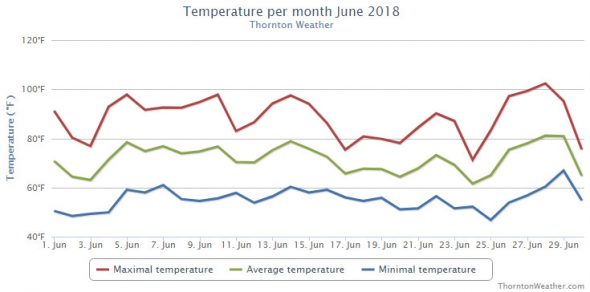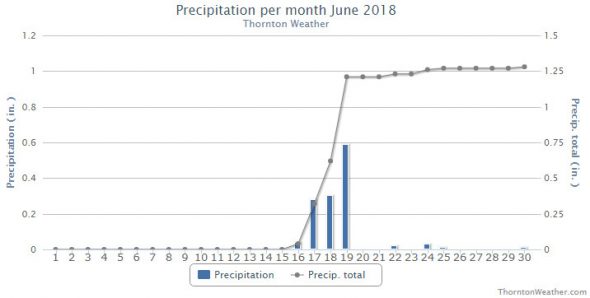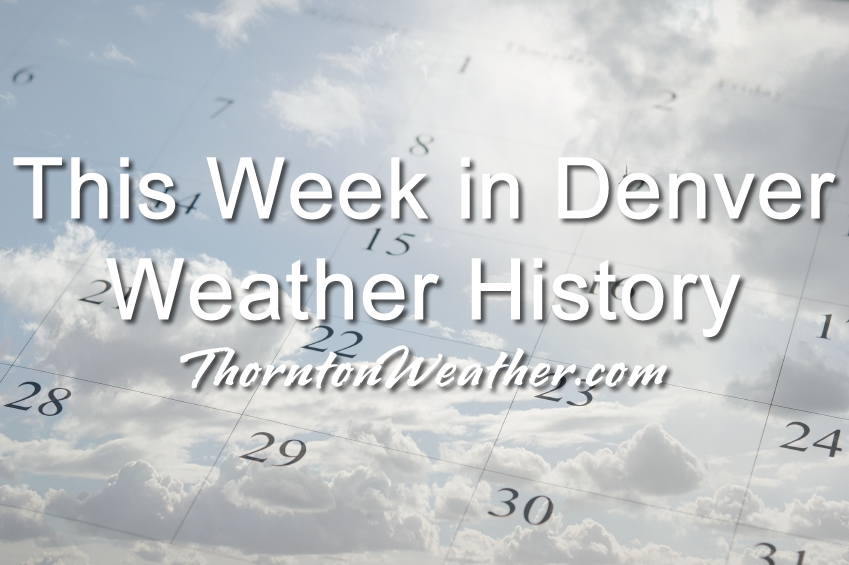
Dangerous lightning, damaging hail and even tornadoes make the highlights of our look back at this week in Denver weather history.
From the National Weather Service:
29-2
In 1990…almost a year to date after the record breaking heat in early July 1989…the third longest heat wave in Denver history started. From June 29th through July 2nd the temperature reached 100 degrees or more on four consecutive days. The highest reading of 102 degrees occurred on the 29th…30th…and 1st. Combined with the 102 degree reading on June 27th this would have been the longest heat wave on record…but the temperature climbed to only 98 degrees on June 28th.
29-15
In 2000…the 29th marked the beginning of a near record hot streak for metro Denver. The high temperatures…as recorded at Denver International Airport…exceeded the 90 degree mark for 17 consecutive days from June 29th through July 15th. The record of 24 consecutive 90 degree or above days was set from July 13th through August 5th…2008.
30
In 1879…dense smoke from mountain forest fires covered the city and obscured the sun as it set behind the mountains.
In 1900…a thunderstorm produced northwest winds to 44 mph with gusts to 58 mph…but only a trace of rain.
In 1917…north winds were sustained to 47 mph with gusts to 52 mph.
In 1942…a strong thunderstorm produced hail and heavy rainfall in south Denver. Leaves were stripped from trees and heavy rain caused street flooding which halted traffic. Hail of unknown size reached a depth of 9 inches on the ground.
In 1965…funnel clouds were observed to the south of Stapleton International Airport and in Jefferson County…15 miles southwest of the airport. Later…a tornado touched down briefly 1 mile east of Littleton…causing only minor damage. Another tornado was observed 12 miles southwest of Stapleton International Airport in Jefferson County. Hail to 3/4 inch in diameter fell in the bear valley area…12 miles south- southwest of Stapleton International Airport. Yet another tornado was sighted 10 miles northwest of the airport. Cloudbursts accompanied by hail battered areas of Arapahoe and Adams counties east of Denver…damaging ripening grain fields. At Lafayette…3.50 inches of rain fell in 30 minutes…causing some flooding.
In 1982…numerous funnel clouds were observed over southwest metro Denver. Only one funnel touched down near the intersection of Jewell and Kipling. The tornado was on the ground for about 5 minutes and caused no damage except for uprooting some trees. In addition…thunderstorms produced heavy rain and hail in the foothills west of Denver. Over an inch of rain fell in a short time near Idaho Springs… Causing clear creek to overflow its banks and flood a few low lying areas of the town. A few people were evacuated… And water and mud entered several stores. The heavy rain also washed out several roads. Hail piled up to a depth of 3 to 4 inches near Idaho Springs. Hail to 3/4 inch was reported at many places across metro Denver including Stapleton International Airport. Lightning struck a chemistry building on the University of Colorado campus in Boulder and started a small fire. Thunderstorm wind gusts to 60 mph were reported near Brighton.
In 1984…heavy rain caused some street and basement flooding in Littleton. One location received 1.56 inches of rain in 75 minutes.
In 1987…a weak tornado near Watkins stayed on the ground for 5 minutes.
In 1990…a small twister touched down in an open field just north of the rocky mountain arsenal. No damage was reported.
In 1998…hail as large as 1 inch in diameter fell near Evergreen.
In 2005…a severe thunderstorm produced hail as large as 3/4 inch near roggen. The hail destroyed a wheat field.
In 2006…the temperature reached a high of 98 degrees at Denver International Airport. This marked the 19th day in June with a maximum temperature of 90 degrees or more setting a new all-time record for the month.
In 2011…very strong thunderstorm winds were also observed across portions of the urban corridor. A peak wind gust to 65 mph was recorded…2 miles northeast of Boulder with a gust to 63 mph at Front Range airport at Watkins and 7 miles southeast of Denver International Airport. The peak wind gust measured at Denver International Airport itself was 45 mph. A severe thunderstorm also produced one inch in diameter hail 2 miles south-southeast of Parker. In addition…a lightning strike destroyed a home in north Denver.
30-1
In 1873…heavy rainfall overnight totaled 1.42 inches. Mountain peaks to the southwest of the city were covered with fresh snow on the morning of the 1st.
1
In 1915…northeast winds sustained to 41 mph with gusts to 50 mph occurred just before a thundershower in the evening. Rainfall was only 0.07 inch.
In 1941…unusually heavy thunderstorm rains flooded basements and blocked traffic. Water was curb high on many downtown streets. The thunderstorm also pelted the city with hail of unknown size. Rainfall in downtown Denver totaled 0.72 inch…but greater amounts likely occurred in other parts of the city.
In 1960…a severe dust devil moving through an Adams County suburban area blew over a fireworks stand…injuring an 11- year-old boy customer and two women operators of the stand. The boy was found under the demolished stand 100 feet away.
In 1961…hail as large as 1 1/4 inches in diameter was reported over east Denver.
In 1967…golf ball size hail fell over portions of metro Denver. Hail stones to 2 inches in diameter damaged roofs and broke windows in northeast Boulder. Marble to golf ball size hail fell at the Boulder airport. A funnel cloud was sighted over the foothills near Boulder. Hail stones of 1 to 2 inches in diameter were measured at Jefferson County Airport near Broomfield. Marble size hail fell in the vicinity of Arvada and Westminster.
In 1982…severe thunderstorms dropped large hail in Denver… Boulder…Commerce City…Lakewood…Wheat Ridge…Golden…and Arvada. Most locations reported hail size from 3/4 to 1 1/4 inches in diameter.
In 1990…the high temperature reached 102 degrees at Stapleton International Airport.
In 1998…hail to 1 1/2 inches in diameter fell near Bennett.
In 2001…the temperature climbed to a high of 101 degrees at Denver International Airport.
In 2016…a severe thunderstorm produced large hail in Castle Rock…ranging in size from 1 to 2 inches in diameter. The hail pummeled neighborhoods as it smashed cars and shattered windows. The storm caused extensive damage to shutters…roofs…siding and fencing.
1-18
In 1874…a streak of 18 consecutive days of 90 degrees tied for second with another streak that was later set in the summer of 1901. The record of 24 consecutive days was established in the summer of 2008.
2
In 1879…a severe hail storm produced considerable damage in the vicinity of Arvada. Some of the stones were unusually large…measuring 6.5 inches in circumference (2 inches in diameter) with an average weight of 1 ounce. The stones were uniformly large with one side concave. The greatest damage was to early wheat…cabbage…and vines. A tree just to the south of the weather station in downtown Denver was struck by lightning. Residents in the house 15 feet away were affected by the strike.
In 1885…thunderstorm winds were sustained to 50 mph in the city.
In 1892…an apparent cold front produced sustained northeast winds to 40 mph with gusts to 45 mph.
In 1955…an apparent microburst wind gust to 69 mph was recorded at Stapleton Airport where the brief strong wind reduced the visibility to zero in blowing dust.
In 1965…hail…up to 2 inches in diameter…struck southwest Adams and northeast Denver counties…damaging cars…windows… And foliage. Hail accumulated up to a foot deep. Wind gusts to 48 mph and hail to 1 inch in diameter fell at Stapleton International Airport where the large hail broke three storm windows and shredded shrubs at the U.S. Weather Bureau upper air building.
In 1968…a pilot reported a tornado 10 miles southeast of Parker.
In 1971…one inch diameter hail stones were reported in Adams County about 30 miles east of Denver.
In 1987…a large tornado touched down 10 miles northeast of Stapleton International Airport. The tornado was vertical and thick and kicked up a large dust and debris cloud. Later…it developed a sinuous rope-like shape as it slowly dissipated. The tornado was visible for 15 minutes. The twister occurred in open country and did only minor damage to a metal shed…porch…and mailbox. A man was killed by lightning in southwest Aurora. He was in his backyard and had a shovel in his hand at the time of the strike. A group of soccer players were hit by lightning on a field in Boulder. A 10-year-old boy was critically injured and hospitalized; fortunately he recovered. Six other people were knocked to the ground by the strike. Two of these were slightly injured. Golf ball size hail fell just east of Littleton and at Highlands Ranch. Hail as large as 3/4 inch in diameter was reported in Aurora and Parker and near Hudson and Franktown.
In 1988…a 45-year-old man was injured by lightning at Cherry Creek Reservoir. Administration of CPR probably saved his life.
In 1990…the temperature reached a high of 100 degrees at Stapleton International Airport.
In 1993…thunderstorm winds blew a roof off a barn near Parker…causing an estimated 15 hundred dollars damage.
In 1994…thunderstorm winds downed power lines in Boulder… Causing power outages. Winds gusted to 66 mph in Boulder… 64 mph in Arvada…and 60 mph in Golden.
In 1998…a small tornado touched down briefly near Barr Lake… But caused no damage.
In 2002…hail as large as 1 3/4 inches in diameter fell in the city of Denver and in Arapahoe County near Littleton. The low temperature of 69 degrees equaled the record high minimum for the date.
In 2006…lightning struck a teenager in Castle Rock as he was mowing his lawn and listening to an iPod. The teen suffered burns to his hands and feet…and had blood running from his ears when he was found. The victim’s eardrums were ruptured…which damaged his hearing. Lightning also struck a house in Castle Rock causing extensive damage to the roof and side of the home. Heavy rains caused flash flooding at Castlewood Canyon State Park near Franktown. The floodwaters destroyed four footbridges along the high trail. A culvert and several roads were washed out in the area. In addition… Two driveways crossing Cherry Creek were washed out near Prairie Canyon Ranch. Heavy rainfall also caused minor flooding on murphy and sand creeks…just east of Buckley AFB. Gun Club Road was closed between Alameda and Mississippi avenues…north of the Murphy Creek Golf Course…where 3 feet of standing water reportedly covered the road. A severe thunderstorm produced large hail to 7/8 inch in diameter in south Aurora near Cherry Creek.
In 2016…a weak landspout touched down briefly in and open field near Bennett.
Continue reading June 30 to July 6: This Week in Denver Weather History

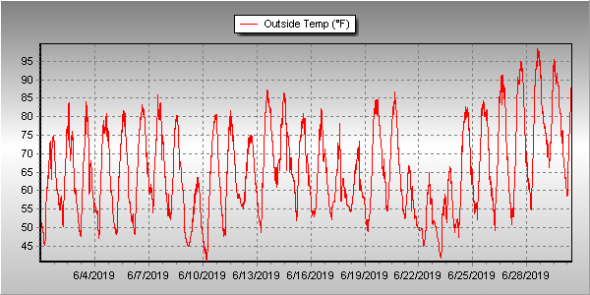
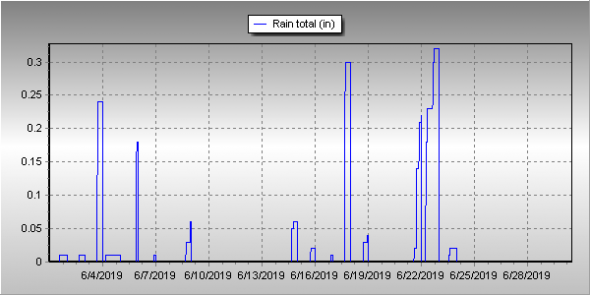
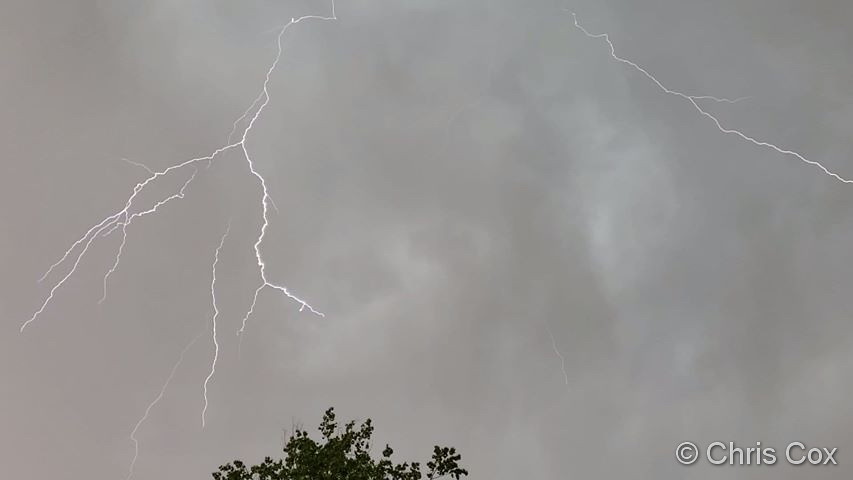
 Extreme weather can occur during in month in Colorado we well know. June however is when traditional spring severe weather arrives in the state oftentimes with hail, damaging wind and tornadoes.
Extreme weather can occur during in month in Colorado we well know. June however is when traditional spring severe weather arrives in the state oftentimes with hail, damaging wind and tornadoes.